The X-Press Pearl Shipwreck off the coast of Sri Lanka has released chemicals and plastic pellets into the ocean, posing a risk of an unprecedented environmental disaster.
Two weeks have passed since the fire erupted on the X-Press Pearl ship off the coast of Colombo, Sri Lanka’s capital. The fire engulfed the nearly 200-meter cargo vessel, causing it to sink to the ocean floor.
But the story is far from over; now the ocean is beginning to speak. In recent days, countless dead fish have washed ashore on Sri Lanka’s coastline. Inside the fish, small plastic pellets have been found.
Numerous dead sea turtles and birds have also been discovered along the Sri Lankan coast in the days following the shipwreck.
Experts warn that the waters in the area are facing an unprecedented environmental disaster as a consequence of the X-Press Pearl shipwreck, according to the Washington Post.
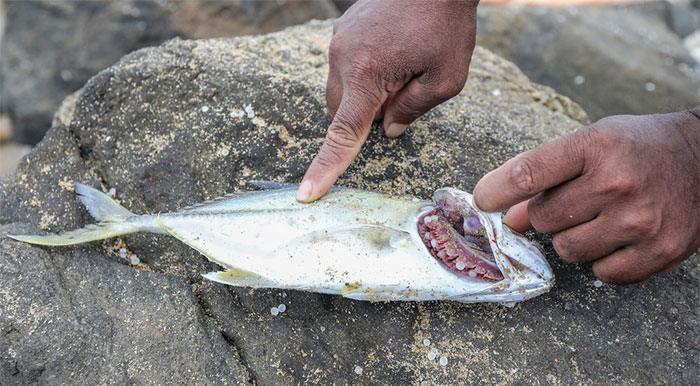
Numerous plastic pellets found inside dead fish washed ashore in Sri Lanka. (Photo: Washington Post).
Last week, satellite images showed that the waters near the site of the shipwreck had changed color, with some experts suggesting that this was due to an oil spill.
On June 12, X-Press Feeders, the company that owns the X-Press Pearl, issued a press release stating that a light gray substance was observed leaking from the ship. However, no reports have yet confirmed the status of fuel pollution.
The Sri Lankan government has not officially announced any oil spill phenomenon. The Sri Lankan Navy is investigating the risk of an oil spill. A spokesperson for the Sri Lankan Navy stated that “sea water samples are being tested to determine the composition of the substances in the spill on the sea.”
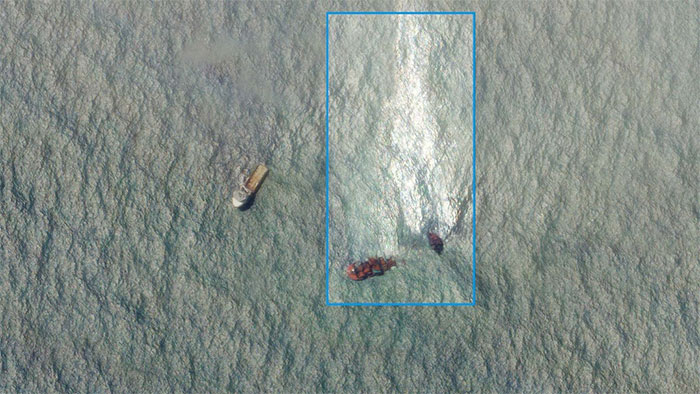
Discolored seawater at the site of the shipwreck. (Photo: Maxar).
Experts indicate that the environmental disaster following the shipwreck has only just begun. The X-Press Pearl was carrying many hazardous chemicals, as well as materials harmful to the environment, which could devastate the marine environment and the living organisms offshore Sri Lanka.
The X-Press Pearl was transporting 1,500 containers, including dangerous goods such as nitric acid, sodium methoxide, and methanol.
In addition to the aforementioned chemicals, the ship was also carrying small plastic pellets, which are harmful to marine life.
“This incident is as serious as a nuclear disaster. This is not just a problem for Sri Lanka. In the coming weeks, the disaster will affect the entire region,” said Muditha Katuwawala, coordinator of the marine conservation organization Pearl Protectors.
According to X-Press Feeders, crew members reported smoke rising from the cargo holds when the ship was near the port of Colombo on May 20. The next day, a fire broke out on the deck.
After receiving the information, the Sri Lankan government dispatched fire-fighting tugboats and helicopters to assist in extinguishing the flames.
By May 22, an explosion occurred on the X-Press Pearl. Satellite images showed flames blazing on the deck while smoke billowed heavily.
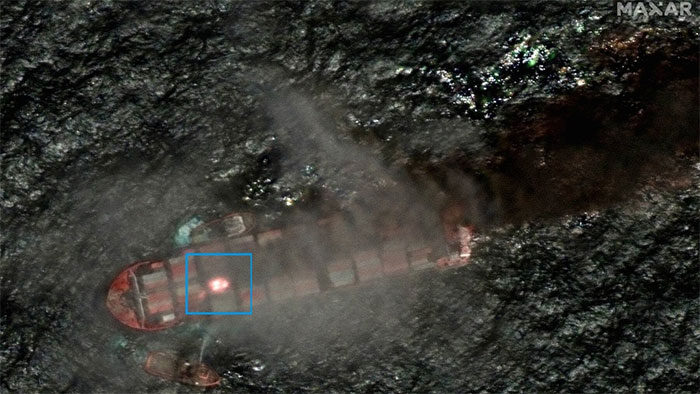
Fire on the X-Press Pearl on May 22. (Photo: Maxar).
On May 25, five days after smoke was reported rising from the cargo, another explosion occurred. The crew of the X-Press Pearl and the firefighters on board were evacuated. Starting from June 2, the ship began to sink to the ocean floor.
As of June 15, the wreck of the X-Press Pearl still lies at the bottom of the ocean. Environmentalists warn of the risk of oil and many hazardous chemicals leaking into the sea.
The cause of the fire on the ship remains unclear. According to Andrew Leahy, a spokesperson for X-Press Feeders, a container containing nitric acid, a chemical used in the production of fertilizers and plastics, may have leaked and led to the fire.
Risks from Chemicals and Plastics
Before the disaster occurred, the crew had requested to dock at Hamad, Qatar, and Hazira, India, to unload the leaking container. However, the authorities at both ports declined the request as they did not have experts to handle leaking containers. The authorities at Hamad and Hazira ports declined to comment on this information.
Among the 1,500 containers on board, 81 contained hazardous goods, including 25 tons of nitric acid.
Currently, divers from the Sri Lankan Navy are investigating the waters where the ship sank. On June 6, the Sri Lankan Navy reported that no unusual phenomena had been observed at sea.
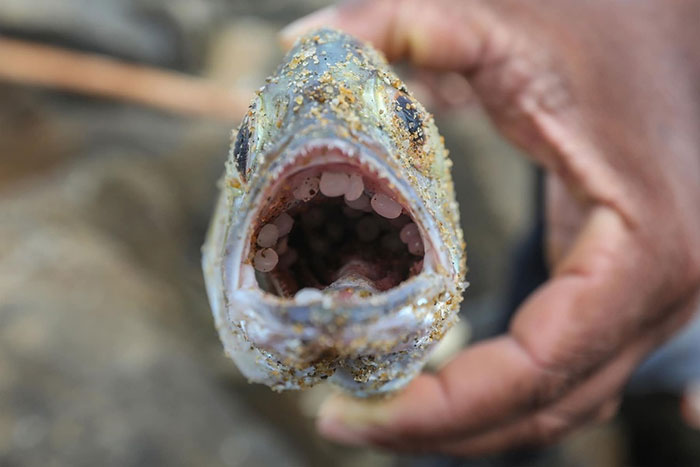
Numerous plastic pellets found inside dead fish washed ashore in Sri Lanka. (Photo: Washington Post).
However, scientists warn that once the chemicals leak out, the ocean ecosystem will be devastated.
“Many chemicals easily interact with seawater“, warned Dureshika Markovich, a chemist working at a scientific facility in California, USA.
The toxic chemicals on the X-Press Pearl include sodium methoxide, caustic soda flakes, and methanol, which can alter the pH balance of seawater and potentially lead to widespread death among various marine species.
Additionally, nitric acid, limestone, and lubricants in the containers, if released, will also disrupt the marine ecosystem.
Ajantha Perera, a scientist and environmental activist from Sri Lanka, stated that any change in the pH balance of the water will alter the species of algae, putting coral reefs at risk of destruction. This phenomenon will affect the food sources for many organisms.
“This marine area could die. Because once the coral reefs are gone, the fish populations will decrease. The ocean will need many years to recover, or it may never return to its former state,” Ms. Perera said.
In recent days, plastic pellets and microplastics from the X-Press Pearl have been found in the bodies of organisms washed ashore in Sri Lanka. Plastic is also filling the beaches, raising ground temperatures and affecting the nesting process of sea turtles.
“The most persistent and widespread impact on the region is plastic. They will remain in the ocean forever,” said Charitha Pattiaratchi, a professor at the University of Western Australia.
Plastic pellets have covered more than 150 km of coastline in western Sri Lanka. The pollution will not stop at the beaches of this South Asian country.
Computer simulations indicate that plastic pellets will continue to spread along ocean currents. The flow of these pellets will soon drift towards Southeast Asia.
“The location of the shipwreck is a breeding and feeding ground for many fish species. Right now, local people are beginning to fear eating fish, which will severely impact the income of fishermen,” a local fisherman said.
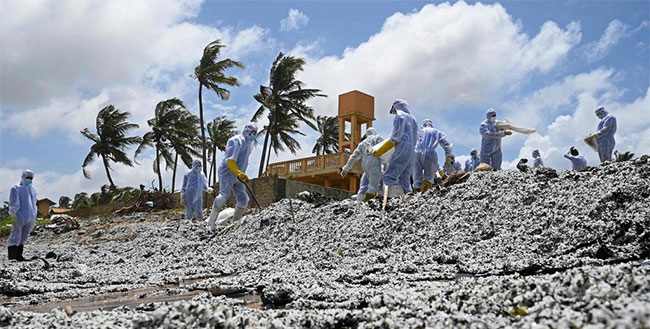
Sri Lankan authorities managing waste washed ashore. (Photo: Washington Post).
Sri Lankan officials have stated that they are urgently working to mitigate environmental damage. As of June 10, the volume of waste collected by authorities has reached 1,075 tons.
However, Professor Pattiaratchi noted that there is still a large amount of plastic debris floating in the sea following the sinking of the X-Press Pearl ship, marking an unprecedented disaster. The plastic particles are expected to reach Indonesia within 60 days, before returning via ocean currents to wash up on the shores of India, the Maldives, or even as far as Africa.
In the next 1-2 years, these plastic particles will drift towards the Cocos (Keeling) Islands and Christmas Island to the west of Australia.



















































